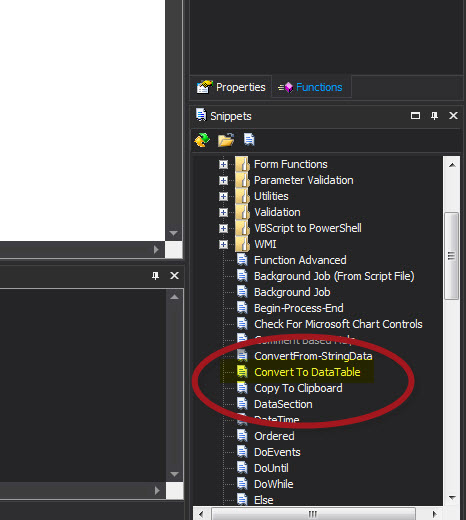

- SAPIEN POWERSHELL STUDIO DATAGRID INVOKE SQLCMD HOW TO
- SAPIEN POWERSHELL STUDIO DATAGRID INVOKE SQLCMD WINDOWS
This command uses an array of character strings as input to the Variable parameter. PS C:\> Invoke-Sqlcmd -Query "SELECT `$(MYVAR1) AS Var1, `$(MYVAR2) AS Var2" -Variable $StringArray Example 3: Invoke a script and pass in variable values from a string PS C:\> $StringArray = "MYVAR1='String1'", "MYVAR2='String2'" The output file may contain proprietary information, so you should secure the output files with the appropriate NTFS permissions. This command reads a file containing Transact-SQL statements and SQLCMD commands, runs the file, and writes the output to another file. Example 2: Invoke commands in a script file and save the output in a text file PS C:\> Invoke-Sqlcmd -InputFile "C:\ScriptFolder\TestSqlCmd.sql" | Out-File -FilePath "C:\ScriptFolder\TestSqlCmd.rpt" This command connects to a named instance of the SQL Database Engine on a computer and runs a basic Transact-SQL script. Examples Example 1: Connect to a named instance and run a script PS C:\> Invoke-Sqlcmd -Query "SELECT GETDATE() AS TimeOfQuery" -ServerInstance "M圜omputer\MainInstance" You can display SQL Server message output, such as those that result from the SQL PRINT statement, by specifying the Verbose parameter. If subsequent result sets after the first set have the same column list, their rows are appended to the formatted table that contains the rows that were returned by the first result set.

If subsequent result sets contain different column lists than the first, those result sets are not displayed. When this cmdlet is run, the first result set that the script returns is displayed as a formatted table. The commands not supported include :!!, :connect, :error, :out, :ed, :list, :listvar, :reset, :perftrace, and :serverlist. This cmdlet does not support the use of commands that are primarily related to interactive script editing. By default, this cmdlet does not set SQLCMD scripting variables. This cmdlet also accepts the SQLCMD scripting variables, such as SQLCMDUSER. This cmdlet also accepts many of the commands supported natively by SQLCMD, such as GO and QUIT. The commands supported are Transact-SQL statements and the subset of the XQuery syntax that is supported by the database engine. The Invoke-Sqlcmd cmdlet runs a script containing the languages and commands supported by the SQL Server SQLCMD utility. $DataSet = New-Object a script containing statements supported by the SQL Server SQLCMD utility. $SqlConnection.ConnectionString = "Server=`"$SQLServer,1433`" Database=`"DATABASE`" IntegragtedSecurity=`"SSPI`"" I don't have anything ready made that I can provide as an example, but if you want, I can look at what you have.

Your $SqlQuery can have PowerShell variables within it that will populated by whatever you supply as a parameter when you execute the function. In this case, I would build a function with the query inside and use PowerShell variables populated by parameters at run time to fill in the blanks in the query.

Research Triangle Powershell User Group remote-capable.Philadelphia PowerShell User Group remote-capable.Madison Power Users Group remote-capable.Denver Microsoft Enterprise Management User Group.NET, POSH is a full-featured task automation framework for distributed Microsoft platforms and solutions.
SAPIEN POWERSHELL STUDIO DATAGRID INVOKE SQLCMD WINDOWS
Windows PowerShell (POSH) is a command-line shell and associated scripting language created by Microsoft.
SAPIEN POWERSHELL STUDIO DATAGRID INVOKE SQLCMD HOW TO
Submission Guidelines | Link Flair - How To


 0 kommentar(er)
0 kommentar(er)
